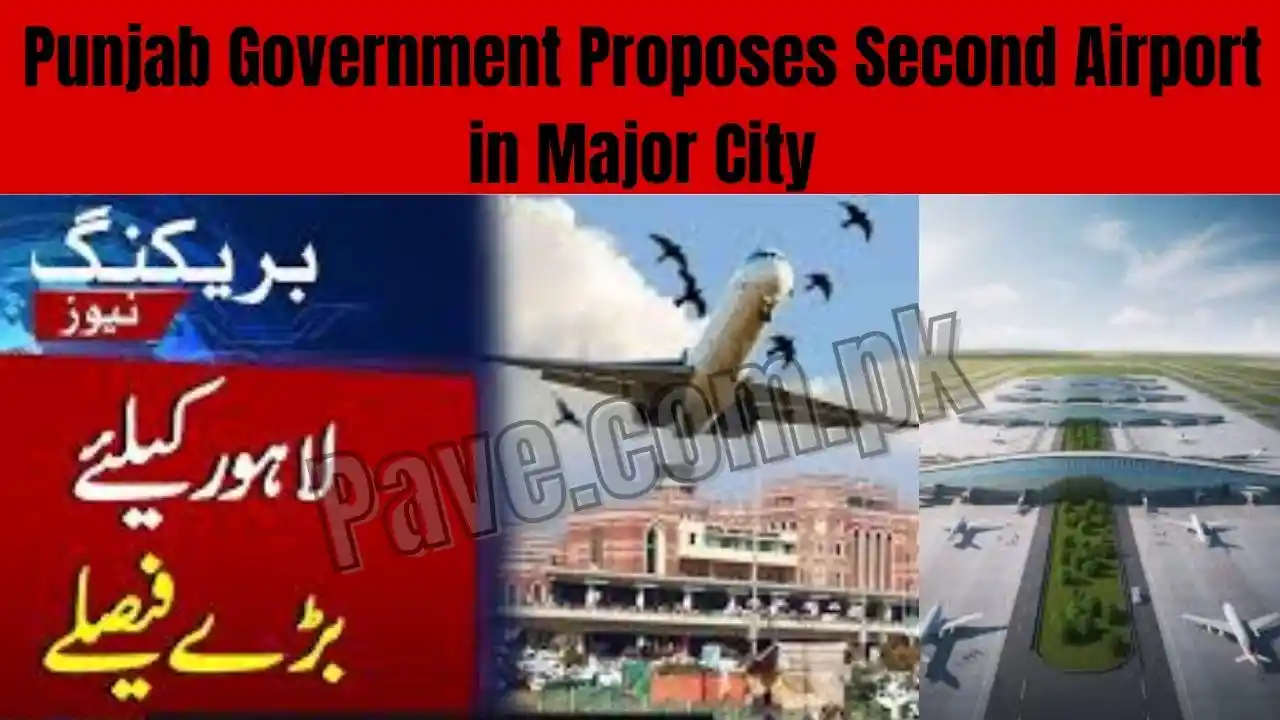Punjab Government Proposes Second Airport in Major City – New Aviation Hub Planned for Economic Growth
In a bold move to reshape Punjab’s economic future, the provincial government led by CM Maryam Nawaz has proposed the establishment of a second major airport in one of Punjab’s high-growth cities. More than just an infrastructure project, this initiative signals a strategic shift toward export acceleration, aviation expansion, and global investment readiness.Punjab Government Proposes Second Airport in Major City
Punjab — home to Pakistan’s fastest-growing urban and industrial centers — has long depended on Lahore’s Allama Iqbal International Airport and the privately-operated Sialkot Airport for both passenger and cargo movements. However, rising trade volume, increasing domestic air travel, and growing demand from international investors have pushed the government to envision a new aviation hub tailored for the future.
Why Punjab Needs a Second Airport — Now More Than Ever
With export industries scaling rapidly, particularly in textiles, sports goods, leather manufacturing, pharmaceuticals, and agriculture, existing airport infrastructure is reaching saturation point. A new airport would address:
| Strategic Need | Purpose |
|---|---|
| Cargo Congestion Relief | Faster processing of export consignments |
| Dedicated International Flight Slots | Reduced delays and improved accessibility |
| Business-Friendly Connectivity | Attract foreign investors and delegations |
| Decentralized Growth | Balance development beyond Lahore and Sialkot |
According to officials, three locations are under serious review — Lahore (South Belt), Faisalabad, and Multan — each offering unique economic advantages.
Read Also: CM Punjab Maryam Nawaz Approves New Industrial Estate in Sialkot
A Catalyst for Industrial, Tourism, and Urban Growth
Unlike traditional airports, the proposed project is expected to function as a multi-dimensional economic hub, incorporating:
- ✈️ Dedicated Cargo Terminals for Exporters
- 🏭 Integrated Industrial Logistics Zones
- 🏨 Airport-Linked Business Parks & Hotel Clusters
- 🚆 High-Speed Road and Metro Connectivity Plans
This concept mirrors successful international aviation models like Dubai World Central (UAE) and Istanbul’s New Mega Airport (Turkey), where airports fuel entire economic ecosystems rather than serving mere transit roles.
Business Community Reacts — “A Much-Needed Leap Forward”
Leaders from the Sialkot and Faisalabad Chambers of Commerce have welcomed the move, calling it a “critical enabler for global trade competitiveness.” Freight operators and airline executives have also noted that direct flight frequency to Europe, the Middle East, and Southeast Asia could significantly increase once capacity is expanded.
What’s Next? Government Finalizing Site and Financing Model
Reports suggest the airport may be developed through:
| Development Model | Possible Structure |
|---|---|
| Public-Private Partnership (PPP) | Government + Private Investors |
| Joint Venture with Aviation Firms | International Airport Operators |
| Build-Operate-Transfer (BOT) | Contractor builds, operates, and later hands over |
A formal announcement is expected once land acquisition and feasibility approvals are finalized
Lahore, the cultural capital of Pakistan, is not only known for its history, cuisine, and hospitality — it also serves as one of the most important aviation hubs in South Asia through the Allama Iqbal International Airport (AIIA). Established as a small terminal decades ago, it has evolved into a major international airport, handling millions of passengers and thousands of cargo operations annually. Today, it stands as the second-busiest airport in Pakistan after Karachi’s Jinnah International Airport — and plays a crucial role in economic expansion, tourism, and trade connectivity.
A Strategic Aviation Hub for Domestic and International Travel
Located in the heart of Lahore, near Cantt. and DHA, Allama Iqbal Airport connects Pakistan to over 60 international destinations, including the Middle East, Europe, North America, and Southeast Asia. Major airlines such as Emirates, Qatar Airways, Etihad, Turkish Airlines, Saudi Airlines, PIA, and AirSial operate regular flights, making it a preferred departure point for expatriates, businessmen, and tourists.
The airport handles:
- ✅ Over 7 million passengers annually
- ✅ More than 30,000 annual aircraft movements
- ✅ Large-scale cargo operations for exports and imports
It is particularly important for exporters in Punjab, as Lahore Airport plays a major role in airlifting perishable goods, apparel, leather products, IT hardware, and medical equipment.
Terminal Facilities and Passenger Experience
The passenger terminal is equipped with multiple lounges, immigration counters, duty-free outlets, currency exchange desks, business-class lounges, prayer areas, and modern food courts.
Recent upgrades introduced:
- ✈ Self-check-in kiosks
- 📱 Digital flight information screens
- 🧳 Improved baggage handling systems
- 🛂 Faster immigration through enhanced e-gate technology
The airport also features separate VIP and VVIP facilities for state guests, delegations, and government officials, often used during international visits and diplomatic receptions.
Read Also: CM Punjab Maryam Nawaz Approves New Industrial Estate in Sialkot
Expansion Plans – Lahore Airport to Be Transformed into a Mega Aviation Complex
To keep up with rising air traffic, the Civil Aviation Authority (CAA) has already initiated Phase-II expansion of Allama Iqbal Airport. The master plan includes:
| Development Component | Details |
|---|---|
| Terminal Enlargement | Expansion of existing building to handle up to 20 million passengers annually |
| New Boarding Gates | More aerobridges and departure lounges |
| Cargo Village Development | Dedicated facility for freight handling |
| Enhanced Runway & Taxiway Capacity | To accommodate larger wide-body aircraft like A380 |
| Smart Security & E-Gate System | For faster immigration clearance |
Authorities have expressed desire to transform Lahore Airport into a regional transit hub, similar to Doha or Dubai (on a smaller scale) — with a strong focus on cargo logistics and commercial aviation.
Economic Contribution – Fueling Punjab’s Growth
Lahore Airport is more than an aviation facility — it is a critical economic engine.
Key Contributions:
| Sector | Impact |
|---|---|
| Exports | Critical for textiles, surgical equipment, fresh produce, and e-commerce shipments |
| Tourism | Gateway for heritage tourism, religious visitors, and business travelers |
| Employment | Thousands of direct jobs in aviation and hospitality, plus support industries |
| Foreign Exchange Earnings | Boost via airline operations, rental shops, and travel-related services |
The airport also enhances global investor confidence, helping entrepreneurs, CEOs, and trade delegations travel seamlessly.
Read Also: Announcement: Punjab Kisan Card Scheme 2025 – Apply Online
Challenges & Future Demands
Despite its success, Lahore Airport faces challenges such as:
- Rush-hour congestion, especially during Hajj and Umrah seasons
- Limited parking space and public transport access
- Need for stronger cargo automation and tracking
However, with ongoing expansion and modernization, most of these issues are gradually being addressed.
Vision for the Future – Lahore as an International Transit Hub
With the Punjab Government’s proposal to build an additional major airport in the province, Lahore’s aviation position is set to strengthen further. Whether the new airport is built in South Lahore, Sheikhupura, or Faisalabad, it will decongest current operations and create dual-airport connectivity, similar to Istanbul, London, or Dubai’s twin airport models.
Experts believe that Lahore could eventually host a dedicated “cargo-only airport zone” — boosting trade efficiency for exporters — while passenger operations continue from Allama Iqbal International Airport.
Punjab Government Proposes Second Airport in Major City Conclusion
Allama Iqbal International Airport is not just a travel facility — it is Punjab’s window to the world. With its rapidly growing traffic, ambitious expansion plans, and strong commercial relevance, it is set to play a defining role in Pakistan’s economic future.
As Lahore takes strides toward becoming a regional aviation and logistics hub, its airport will remain the heartbeat of global connectivity, trade acceleration, and modern mobility.







